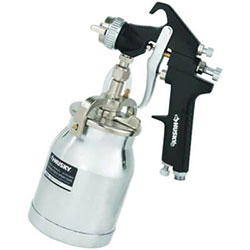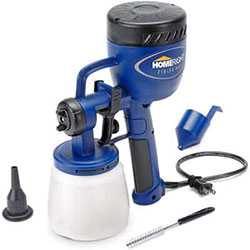The Best Paint Sprayer for Trim and Doors — Buyer’s Guide, How-To, Reviews, and Comparison
Time to say goodbye to your paintbrush, and switch to the best paint sprayer for trim and doors instead. Providing a more even coat than the traditional handheld method can achieve, these machines can knock out the door-covering staples of lacquers, shellacs, varnishes, oil glosses, and urethanes — faster than a brush and with no lost bristles or stroke marks. With the category including everything from compact handhelds through to externally-powered turbines — there’s a sprayer for single or multi-door projects. And, at a variety of price-points and output ratings — both casual DIYers and pro-trade users can find the ultimate unit.
- Backed by the mighty Wagner SprayTech.
- Ideal for home interiors.
- Arrives with a viscosity cup and cleaning brush.
- Lightweight and compact.
Best Paint Sprayer for Trim and Doors Information
Paint Sprayers For Door Trim Comparison Table
| IMAGE | PRODUCT | DETAILS | ||
|---|---|---|---|---|
|
Best for DIY 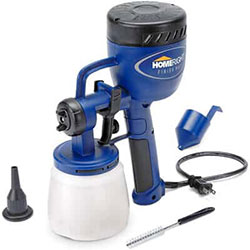
|
Best for DIY
|
Features
|
Check Price at Amazon HomeRight Finish Max Review HomeRight Finish Max Review | |
|
Best for Door and Trim Stains 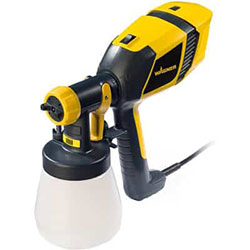
|
Best for Door and Trim Stains
|
Features
|
Check Price at Amazon Wagner Control Spray 250 Review Wagner Control Spray 250 Review | |
|
Best External Turbine 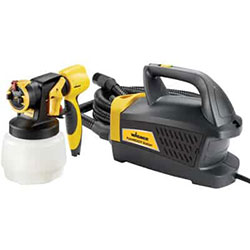
|
Best External Turbine
|
Features
|
Check Price at Amazon Wagner PaintREADY Review Wagner PaintREADY Review | |
|
Best for Versatility 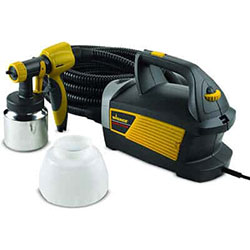
|
Best for Versatility
|
Features
|
Check Price at Amazon Wagner Control Spray Review Wagner 518080 Control Spray Max Review | |
|
Best for Intricate Trim 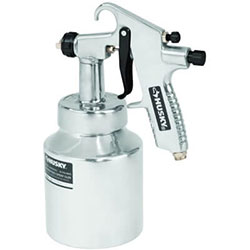
|
Best for Intricate Trim
|
Features
|
Check Price at Amazon Husky H4930SSG Review Husky H4930SSG Review | |
|
Best Professional Grade 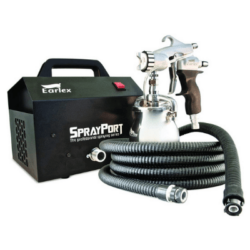
|
Best Professional Grade
|
Features
|
Check Price at Amazon Earlex Spray Port 6003 Review Earlex Spray Port 6003 Review | |
|
Best for Overhangs 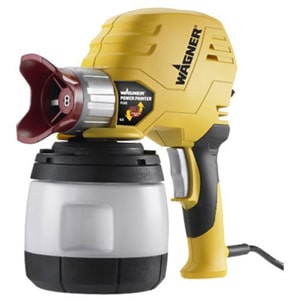
|
Best for Overhangs
|
Features
|
Check Price at Amazon Wagner Power Painter Plus Review Wagner Power Painter Plus Review | |
|
Best Airless 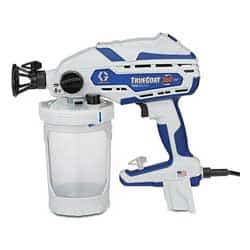
|
Best Airless
|
Features
|
Check Price at Amazon Graco Truecoat 360 VSP Review Graco Truecoat 360 VSP Review |
The Best Paint Sprayer for Trim and Doors Buying Guide
These versatile power painters make light work of refreshing your woodwork, deliver a cleaner finish than a brush or a roller, and require less physical effort than manual application tools.
With units capable of knocking out the door and trim covering staples of varnishes, stains, lacquers, and oil-based mediums — there’s a tool for every application, whether you’re a casual DIYer or a property renovation professional.
Why You Need the Best Paint Sprayer for Doors and Trim
External openers and casings are exposed to wind, rain, frost, and ultraviolet light — not just fading the paint but also making them subject to the erosive power of all that Mother Nature can throw at them. Furthermore, both inside and outside trim and doors have to endure knocks, bumps, continual opening and closing, and the constant groping of dirty and oily hands — a problem that’s exacerbated if you have young children.
This means that to keep your internal and external coated woodwork looking in top condition — they need at least annual attention.
Sure, you can whip out your trusty brush from your toolbox — but why make life hard for yourself?
The advantages of using a paint sprayer for trim and doors include:
- Up to ten times faster than using a brush.
- Delivers a finely-atomized spray for the perfect finish.
- No risk of wayward bristles ruining your final coat.
- Eliminates tell-tale brush marks.
- Can deliver paints, lacquers, and stains with one tool.
- Requires less effort than using a brush.
- It’s like the DIY version of playing Call of Duty — kinda.
What Paints Can You Use With a Trim and Door Sprayer?
All of them.
Ok, admittedly, that’s not strictly true. Most machines that are suitable for door and trim spraying will not have the power nor the correct nozzle to knock out block fillers, epoxies, elastomerics, textured mediums, or roof coatings. But then, chances are you’re not going to be using these seriously viscous paints on your doors (if you’re after a high-density compatible machine, check out my article on thick paint units).
Sure, covering your living room gateway with tar-based roof paint will be remarkably durable and stand up to everything little Jimmy or Jenny can throw at it — but it will look ridiculous.
However, the best door sprayers are capable of propelling the most commonly used mediums for woodwork coverage, including:
- Lacquers.
- Shellacs.
- Stains.
- Sealers.
- Weatherproofers.
- Oil-based paints.
How to Choose the Best Door and Trim Paint Sprayer
Here a few areas I suggest checking out when picking out your perfect sprayer.
Paint Sprayer Format
Turbines for Door Painting
Being lightweight, portable, and affordable, they’re excellent home-use machines, exemplified by the impressive Wagner PaintREADY Station. These units typically feature HVLP (high-volume low-pressure) tech to deliver a fine coat with the minimum of overspray. This reduces dripping and pooling, creating a rewarding finish on both internal and external projects.
Airless Units
Compared to turbines — which knock out about 5-10 PSI — these powerful hydraulic units deliver around 3000 PSI — making them excellent at propelling dense paints. These machines, such as the Graco TrueCoat 360, can therefore be useful for door-work if you’re utilizing thick mediums such as base primers or heavy oils.
Airless sprayers are also renowned for their remarkable speed of coverage — the most rapid of all sprayer formats. However, unless you’re attacking a multitude of doors and trims in one session — or addressing a medieval castle’s drawbridge — this swift coating feature will be of little benefit.
Pneumatic Guns
As these guns are powered by an external compressor — they’re particularly unsuitable for indoor work — unless you want to injure yourself by hauling a hefty air behemoth around your property.
That said, pneumatic guns provide the cleanest and most accurate finishes of all paint sprayers. Hence, if you have an antique door, or molded trim with intricate features, they are worthy of consideration. Compressor-driven shooters such as the Husky H4930SSG are excellent at providing precise delivery.
Handheld or External Drive
For the majority of door and trim projects, a handheld unit like the Wagner 250 will be sufficient.
By incorporating the turbine or hydraulic pump inside the gun housing — these tools are compact and portable. Furthermore, with most machines featuring a one-quart container or larger, just one fill will have sufficient capacity to cover both sides of a door and surrounding woodwork.
That said, externally-driven sprayers have their place. As there is only so much weight your hand can hold, the power units on handheld sprayers are restricted in size. However, this isn’t the case with external units that sit on the floor — allowing them to incorporate beefier turbines or hydraulics, delivering greater output.
Hence, these machines, such as the Control Spray Max, are excellent if your projects include dense oils or primers. Furthermore, as they’re capable of also knocking out thick latexes, milks, and chalks — they can double up as a comprehensive home redecoration machine, allowing you to also use them for addressing walls and ceilings.

Nozzle Tips
The nozzle type and size determine the density of paints you can propel, the accuracy of application, and the smoothness of the coat.
Typically, smaller tips provide fine atomization, a clean finish, and precise delivery. Larger nozzle ends permit the usage of thicker viscosity mediums and more rapid coverage than their narrow counterparts.
For advice on the correct tip selection — check out my nozzle 101 guide.
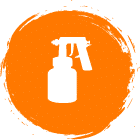
Cord and Hose Length
However, as the majority of US doors measure 36 inches by 80 inches — you don’t need such long snakey cords and hoses as you would if you were spraying a car or boat.
Also, bear in mind that bigger is not always better — despite what your girlfriend, partner, or wife may tell you. If your lead or hose is excessively lengthy, it can become a hindrance, tripping hazard, or strangulation risk.
How to Paint Doors and Trim With a Spray Gun
But before we get to the crucial info on how to spray paint interior doors, external doors, and trim — use the following checklist to ensure you have everything you need.
What You Will Need to Follow This Tutorial
Painting the exterior of your house gives it a new lease of life, becomes the envy of the neighbors, and can deliver valuable curbside appeal if you’re thinking of selling. Before you dive into my external house painting 101 — here’s a list of everything you will need.
- A sprayer suitable for doors and trim — such as the HomeRight Finish Max.
- Step ladder — if you’re vertically challenged.
- Masking tape and drop cloths.
- Paint stirrer sticks.
- Paint — lacquer, varnish, stain, or gloss, depending on the requirement.
- Mixing cups.
- Paper.
- Cardboard or bucket for test spraying.
- Paint scraper.
- Sandpaper.
- Paint thinner.
- Wood filler.
- Hot air gun.
- Appropriate nozzle for the paint type.
- Sponge and soapy water.
- Screwdrivers.
- Clamping sawhorse.
- Polythene sheets.
- Overalls.
- Dust mask, safety goggles, and painting gloves.
- Extension cable if operating a distance away from power outlets.
How to Spray Paint Doors and Trim — Step By Step Guide
Step 1 — Preparation
- Put on your protective gear.
- If working on internal doors and trim, remove as much furniture and objet d’art from the room as possible. Should some items be too bulky or awkward to relocate, cover with drop cloths or poly sheeting. Trust me, it’s better to spend time with these precautions than trying to explain later to your wife why there’s a gallon of paint on her heirloom coffee table.
- Protect the wall surfaces/external brickwork surrounding the trim with masking tape and polythene sheets or paper. Additionally, check that the floor area in the immediate vicinity is protected from wayward splashes, drips, and spills.
- While not essential, removing the door from its casing is preferable. This allows you to paint the door in a horizontal position — which reduces the likelihood of drips. Use a suitable screwdriver to undo the hinges — and ideally, have the assistance of a buddy to help you carry the door. They’re heavier than they look.
- Position the door horizontally on your sawhorses. If you don’t have one of these valuable work tools, you can use a robust table instead.
- Remove all door hardware — handles, locks, knockers, numbers, letterboxes, etc. and store safely away from the paint sprayer.
- Sand all the woodwork of both the trim and doors with abrasive paper — this allows for better adhesion of the new coat and ensures a perfectly clean finish. If you want to remove the old paint back down to the wood, and recoat with varnish or shellac, use a heat gun and paint scraper. I’ve put together a guide here.
- Check the wood for knicks, cuts, scratches, cracks, or holes — fill with wood filler and then sand again.
- Wash the doors and trim with warm soapy water and a sponge — allow them to dry thoroughly before starting on spray painting.
Step 2 — How to Spray Paint Trim and Doors With a Spray Gun
- If required, dilute the paint with thinners for oil-based stains, sealers, and varnishes. Mix thoroughly in a mixing cup with a wooden stirrer.
- Set up your paint sprayer according to the manufacturer’s instructions — utilizing an extension cord if needed. As a general guide, I’ve gathered some info on preparing and using turbine, airless, and pneumatic machines.
- Perform a test spray on a piece of waste cardboard or into a bucket. Keep the sprayer on the lowest power setting possible that adequately propels the paint. This will minimize overspray and dripping — allowing for the most precise application.
- Spray at a distance of 8-12 inches from the target area. On trim, use one continuous movement either from left-to-right or top-to-bottom depending on the orientation of the molding, casing, or architrave. On doors, follow the grain of the wood or panels and overlap each pass by 30-50 percent.
- Wait for the paint to dry. In daylight conditions, not artificial light, check the level and evenness of coverage. If required, give another coat.
- If any corners or edging have escaped the new paint coat — touch up with a small paintbrush.
- Remove all masking tape, sheeting, and paper and uncover your furniture.
- Reattach any door hardware, and then, with the assistance of a buddy, rehang the door.
- Thoroughly rinse, flush, and clean your paint sprayer. This extends your power tool’s longevity and ensures a detritus-free coat the next time you use the machine. Here’s my 101 on Sprayer Cleaning.
- Sit back in your armchair/stand on your driveway and admire your handiwork. Take a photo and post on Instagram #toolnerds #mydoorisbetterthanmyneighbors #DIYersdoitwithalonghose.
Our Picks of the Best Paint Sprayer for Doors and Trim
Straightforward in operation and affordable, yet also delivering impressive versatility, this handheld HVLP turbine machine is ideal for the home user who demands a portable and compact unit.
Three fan patterns, vertical, horizontal, and circular, provide you with the perfect means of address for your delivery method — horizontal for up-and-down strokes, vertical for side-to-side, and circular for corners and trim moldings.
At the heart of the sprayer is a 400-watt turbine. If this grunty motor is too intense for thin door and trim sealers and stains, you can step down the material flow level with a quick turn of a dial, preventing overspray, dripping, and pooling.
And, while the brand may not be the first one that springs to mind when you think about sprayers — you gain peace of mind knowing it’s owned by the mighty paint specialists Wagner SprayTech.
- Features a balanced design for ease-of-use.
- Brass tip.
- Excellent home interior unit.
- Suitable for both experienced DIYers and spraying newbies.
- Includes a viscosity cup and cleaning brush.
- Short 18-inch cord — most jobs will require an extension.
- Design
- Functionality
- Price
Straightforward in operation and affordable, yet also delivering impressive versatility, this handheld HVLP turbine machine is ideal for the home user who demands a portable and compact unit.
Three fan patterns, vertical, horizontal, and circular, provide you with the perfect means of address for your delivery method — horizontal for up-and-down strokes, vertical for side-to-side, and circular for corners and trim moldings.
The modest 0.84-quart cup keeps weight to a minimum — while still promising sufficient capacity to cover an entire door and concomitant framing. Furthermore, the gun-end features a wide 2.00 mm brass tip — not only giving greater durability than the nylon versions of its counterparts, but also permitting the delivery of high-density paints.
At the heart of the sprayer is a 400-watt turbine. If this grunty motor is too intense for thin door and trim sealers and stains, you can step down the material flow level with a quick turn of a dial, preventing overspray, dripping, and pooling.
And, while the brand may not be the first one that springs to mind when you think about sprayers — you gain peace of mind knowing it’s owned by the mighty paint specialists Wagner SprayTech.
- Features a balanced design for ease-of-use.
- Brass tip.
- Excellent home interior unit.
- Suitable for both experienced DIYers and spraying newbies.
- Includes a viscosity cup and cleaning brush.
- Short 18-inch cord — most jobs will require an extension.
- Design
- Functionality
- Price
It boasts Wagner’s proprietary Control Finish nozzle — a tip that effortlessly delivers stains, lacquers, sealers, and urethanes — although more viscous paints will require thinning.
The lightweight and compact design of this handheld turbine unit allow for fuss-free maneuverability and fatigue-free operation. And, knocking out 1.25 liters per minute — it will cover an 8-foot by 10-foot area in less than two minutes.
This sprayer incorporates a 0.84-quart paint cup. With trademarked Lock-N-Go technology, it can be effortlessly removed together with the nozzle for straightforward post-project cleaning.
Furthermore, in addition to its choice of three spray patterns, this detail door sprayer boasts a material flow dial — enabling you to adjust the delivery intensity to suit the density of your stain or sealer.
- Extensive warranty.
- The best paint sprayer for trim and intricate features.
- Rated for both indoor and outdoor door painting.
- Lacquer, urethane, and varnish compatible.
- Easy-to-reach top-mounted on/off switch.
- Loud for a small, compact sprayer.
- Not suitable for dense paints.
- Design
- Functionality
- Price
It boasts Wagner’s proprietary Control Finish nozzle — a tip that effortlessly delivers stains, lacquers, sealers, and urethanes — although more viscous paints will require thinning.
The lightweight and compact design of this handheld turbine unit allow for fuss-free maneuverability and fatigue-free operation. And, knocking out 1.25 liters per minute — it will cover an 8-foot by 10-foot area in less than two minutes.
Its six-foot mains lead should provide sufficient freedom without becoming a tripping risk. Additionally, it includes a cord-protector where the cable meets the gun handle — extending its longevity.
This sprayer incorporates a 0.84-quart paint cup. With trademarked Lock-N-Go technology, it can be effortlessly removed together with the nozzle for straightforward post-project cleaning.
Furthermore, in addition to its choice of three spray patterns, this detail door sprayer boasts a material flow dial — enabling you to adjust the delivery intensity to suit the density of your stain or sealer.
- Extensive warranty.
- The best paint sprayer for trim and intricate features.
- Rated for both indoor and outdoor door painting.
- Lacquer, urethane, and varnish compatible.
- Easy-to-reach top-mounted on/off switch.
- Loud for a small, compact sprayer.
- Not suitable for dense paints.
- Design
- Functionality
- Price
Featuring a ground-sitting power unit, the weight of the gun is reduced — allowing you to effortlessly wield the shooter for extended periods of time without suffering fatigue. That said, as it promises delivery seven times faster than a brush — working time will be kept to a minimum.
A twin-speed turbine permits you to adjust the output grunt, ensuring that thinner paints aren’t oversprayed and pooling is reduced. Furthermore, its generous 15-foot hose will negate the requirement for an extension cord on most home door projects — and, being non-kinking, it prevents unwanted downtime.
The acrylic paint container, with Lock-N-Go tech, has a capacity of 1.5 quarts — the largest volume in this trim and door review rundown. Additionally, with the turbine casing having an integrated handle — transportation around the home or garden is relatively effortless.
- Easy-to-clean turbine housing.
- Suitable for unthinned paints.
- Delivers 15 ounces of coverage medium per minute.
- Horizontal, vertical, and circular spray pattern choice.
- Adjustable material volume flow dial.
- Lacks durability for intense outdoor use.
- Doesn’t arrive with a finishing head for intricate trim.
- Design
- Functionality
- Price
Featuring a ground-sitting power unit, the weight of the gun is reduced — allowing you to effortlessly wield the shooter for extended periods of time without suffering fatigue. That said, as it promises delivery seven times faster than a brush — working time will be kept to a minimum.
This sprayer boasts Wagner’s versatile iSpray head — not just ideal for atomizing the door and trim staples of urethanes, stains, and lacquers, but also capable of propelling dense mediums such as latex. Hence, making the unit a complete DIY unit — allowing you to coat walls and ceilings too.
A twin-speed turbine permits you to adjust the output grunt, ensuring that thinner paints aren’t oversprayed and pooling is reduced. Furthermore, its generous 15-foot hose will negate the requirement for an extension cord on most home door projects — and, being non-kinking, it prevents unwanted downtime.
The acrylic paint container, with Lock-N-Go tech, has a capacity of 1.5 quarts — the largest volume in this trim and door review rundown. Additionally, with the turbine casing having an integrated handle — transportation around the home or garden is relatively effortless.
- Easy-to-clean turbine housing.
- Suitable for unthinned paints.
- Delivers 15 ounces of coverage medium per minute.
- Horizontal, vertical, and circular spray pattern choice.
- Adjustable material volume flow dial.
- Lacks durability for intense outdoor use.
- Doesn’t arrive with a finishing head for intricate trim.
- Design
- Functionality
- Price
The machine includes both one-quart and 1.5-quart cups — the smaller metallic container for lightweight use on detail projects and a larger acrylic cup for more substantial jobs. And, connected with quick-screw fittings — they can be rapidly removed for speedy replenishment should your work demand it.
A substantial rear-mounted dial permits you to adjust volume flow, while its 20-foot hose should negate the need for extension rods and cables. Furthermore, proprietary Lock-N-Go tech enables rapid dismantling — for either fuss-free cleaning or blockage removal.
Additionally, a molded ergonomic front-rubberized handle allows for fatigue-free use and a secure grip — increasing accuracy. And, with a choice of spray patterns — you can adjust the fan to suit both your coating medium and target material.
- A hi-specced DIY turbine that’s suitable for beginners.
- Robust stationery base.
- Low bounce-back.
- Control Finish nozzle designed for urethanes, stains, sealers, and varnishes.
- Incorporated pressure control dial.
- Latex paints and some shellacs will need thinning.
- Design
- Functionality
- Price
The machine includes both one-quart and 1.5-quart cups — the smaller metallic container for lightweight use on detail projects and a larger acrylic cup for more substantial jobs. And, connected with quick-screw fittings — they can be rapidly removed for speedy replenishment should your work demand it.
At the business end of the sprayer, the gun features Wagner’s Control Finish nozzle — an accurate tip that keeps overspray to a minimum while propelling a finely atomized paint plume. Furthermore, with adjustable spray widths from 0.5 to 12 inches — you can tailor the application for either precise jobs or speedy coverage.
A substantial rear-mounted dial permits you to adjust volume flow, while its 20-foot hose should negate the need for extension rods and cables. Furthermore, proprietary Lock-N-Go tech enables rapid dismantling — for either fuss-free cleaning or blockage removal.
Additionally, a molded ergonomic front-rubberized handle allows for fatigue-free use and a secure grip — increasing accuracy. And, with a choice of spray patterns — you can adjust the fan to suit both your coating medium and target material.
- A hi-specced DIY turbine that’s suitable for beginners.
- Robust stationery base.
- Low bounce-back.
- Control Finish nozzle designed for urethanes, stains, sealers, and varnishes.
- Incorporated pressure control dial.
- Latex paints and some shellacs will need thinning.
- Design
- Functionality
- Price
This pneumatic compressor-driven shooter features a multi-medium compatible 1.8 mm stainless steel tip. Compatible with enamels, urethanes, shellacs, stains, and varnishes — it provides a showroom-like finish with the minimum of overspray, bounceback, and pooling.
In addition to adjustable material flow and airflow delivery, this sprayer also boasts a wide width size spectrum — from 1.1 to 11.5 inches. Thus making the unit effortlessly address both intricate trim and wide expanses of doors. And, working at four CFM (cubic feet per minute) at 45 PSI — this gun will be suitable for use with the vast majority of consumer-sized home compressors.
The gun features a textured handle, ensuring a reliable grip even with perspiring or paint-covered hands. And, with easy-pull trigger tech, it should stave off finger fatigue on longer projects.
- Excellent for fine-finishing and precise door and trim work.
- Integrated storage hook.
- Includes a gun wrench and a cleaning brush.
- Aluminum construction prevents corrosion.
- Pro-grade pneumatic gun at a DIY price.
- The container can drip if used extensively away from the horizontal.
- Some DIYers may find the trigger overly sensitive.
- Weighs 2.2 pounds — hefty for a finishing gun.
- Design
- Functionality
- Price
This pneumatic compressor-driven shooter features a multi-medium compatible 1.8 mm stainless steel tip. Compatible with enamels, urethanes, shellacs, stains, and varnishes — it provides a showroom-like finish with the minimum of overspray, bounceback, and pooling.
The 1.05-quart aluminum cup ensures both durability and pleasing capacity — while a quick-release feature allows for speedy paint replenishment, or enables you to switch rapidly between paint types.
In addition to adjustable material flow and airflow delivery, this sprayer also boasts a wide width size spectrum — from 1.1 to 11.5 inches. Thus making the unit effortlessly address both intricate trim and wide expanses of doors. And, working at four CFM (cubic feet per minute) at 45 PSI — this gun will be suitable for use with the vast majority of consumer-sized home compressors.
The gun features a textured handle, ensuring a reliable grip even with perspiring or paint-covered hands. And, with easy-pull trigger tech, it should stave off finger fatigue on longer projects.
- Excellent for fine-finishing and precise door and trim work.
- Integrated storage hook.
- Includes a gun wrench and a cleaning brush.
- Aluminum construction prevents corrosion.
- Pro-grade pneumatic gun at a DIY price.
- The container can drip if used extensively away from the horizontal.
- Some DIYers may find the trigger overly sensitive.
- Weighs 2.2 pounds — hefty for a finishing gun
- Design
- Functionality
- Price
The external fan motor is housed in a substantial and robust metal casing — shielding it from the knocks, bumps, and abuse it may suffer through extreme utilization. Furthermore, boasting reinforced couplings — intense movement of the lengthy 25-foot hose shouldn’t induce premature degradation.
This unit includes an all-metal construction Pro8 gun with a fine atomizing 1.3 mm stainless steel tip. It permits the adjustment of spray pattern, airflow, and medium volume flow — while also boasting a substantial rubberized handle for a secure grip.
The one-quart rapid-release aluminum cup permits speedy refilling and should have sufficient capacity for the majority of trim and door jobs. Furthermore, internally coated with PTFE (also known as Teflon or polytetrafluoroethylene) — it’s shielded against corrosion and allows for effortless post-project cleaning.
- 200-watt motor.
- 0.12 GPM flow rate.
- Air cap turns through 360 degrees — permitting multi-angle painting.
- Non-bleed gun with minimal overspray.
- 25-foot non-kinking HyperFlex hose.
- May be overkill for the casual DIYer.
- Loud operation.
- Design
- Functionality
- Price
The external fan motor is housed in a substantial and robust metal casing — shielding it from the knocks, bumps, and abuse it may suffer through extreme utilization. Furthermore, boasting reinforced couplings — intense movement of the lengthy 25-foot hose shouldn’t induce premature degradation.
At the core of this sprayer is a powerful three-stage turbine that knocks out 5.5 PSI with 12 gallons per minute delivery. Not only enabling rapid completion of larger jobs, but also allowing the machine to deliver denser paint and trim mediums, such as thick shellacs and primers.
This unit includes an all-metal construction Pro8 gun with a fine atomizing 1.3 mm stainless steel tip. It permits the adjustment of spray pattern, airflow, and medium volume flow — while also boasting a substantial rubberized handle for a secure grip.
The one-quart rapid-release aluminum cup permits speedy refilling and should have sufficient capacity for the majority of trim and door jobs. Furthermore, internally coated with PTFE (also known as Teflon or polytetrafluoroethylene) — it’s shielded against corrosion and allows for effortless post-project cleaning.
- 200-watt motor.
- 0.12 GPM flow rate.
- Air cap turns through 360 degrees — permitting multi-angle painting.
- Non-bleed gun with minimal overspray.
- 25-foot non-kinking HyperFlex hose.
- May be overkill for the casual DIYer.
- Loud operation.
- Design
- Functionality
- Price
It boasts EZ-Tilt tech — that is, a pivoting suction tube inside the one-quart container that always remains submerged in the painting medium. Meaning that even when spraying at angles away from the horizontal — such as on the underside of door housings — the delivery remains constant and splutter-free.
The gun includes a substantial two-finger trigger, allowing for fatigue-free depression on larger jobs. And, with a one-quart acrylic paint container, there shouldn’t be any requirement to refill on one-door jobs.
Knocking out around 6.6 gallons per hour, this unit should ensure jobs are completed in a timely fashion. Additionally, arriving complete with a storage case — the sprayer can be effortlessly transported from job-to-job and provides reassuring protection of your power tool.
- Ideal for overhead projects.
- Compatible with water and oil-based stains and paints.
- Choice of horizontal or vertical spray patterns.
- Substantial spray tip guard.
- Quick-release twist-lock cup.
- A relatively heavy machine when laden with paint.
- Noisy compared to handheld turbines.
- Design
- Functionality
- Price
It boasts EZ-Tilt tech — that is, a pivoting suction tube inside the one-quart container that always remains submerged in the painting medium. Meaning that even when spraying at angles away from the horizontal — such as on the underside of door housings — the delivery remains constant and splutter-free.
This powerful sprayer features a Wagner’s proprietary Optimus tip — capable of delivering thin trim urethanes and varnishes and also dense door primers and shellacs. Furthermore, a rear-mounted switch permits you to select the optimum power output for either stains or paint.
The gun includes a substantial two-finger trigger, allowing for fatigue-free depression on larger jobs. And, with a one-quart acrylic paint container, there shouldn’t be any requirement to refill on one-door jobs.
Knocking out around 6.6 gallons per hour, this unit should ensure jobs are completed in a timely fashion. Additionally, arriving complete with a storage case — the sprayer can be effortlessly transported from job-to-job and provides reassuring protection of your power tool.
- Ideal for overhead projects.
- Compatible with water and oil-based stains and paints.
- Choice of horizontal or vertical spray patterns.
- Substantial spray tip guard.
- Quick-release twist-lock cup.
- A relatively heavy machine when laden with paint.
- Noisy compared to handheld turbines.
- Design
- Functionality
- Price
Graco’s trademarked VacuValve technology means you can spray in any direction with no loss of power or uneven coating — permitting you to spray horizontally on doors mounted in-situ, downwards onto sawhorses, or upwards to address door trim casings.
A novel inclusion is Graco’s trademarked FlexLiner system. These 1.31-quart disposable bags fit inside the paint container, negating the requirement to clean the cup post-use and permitting rapid changes of coverage medium.
Made in the USA, in addition to the gun, liners, and tips — this sprayer arrives complete with a storage case.
- Variable 500 to 1500 PSI output.
- Includes four FlexLiner paint bags.
- Compatible with thin and viscous paints.
- Stainless steel internal hydraulic pump promotes longevity.
- Robust spray tip guard prevents accidental damage.
- 18-inch power cord — one of the shortest on the market.
- Disposable bags may not appeal to the environmentally conscious.
- 25-gallons per year throughput rating may be insufficient for some users.
- Design
- Functionality
- Price
Graco’s trademarked VacuValve technology means you can spray in any direction with no loss of power or uneven coating — permitting you to spray horizontally on doors mounted in-situ, downwards onto sawhorses, or upwards to address door trim casings.
The gun includes two 0.015 inch tips — one delivering an accurate four-inch spray for trim, and the other providing a wider twelve-inch fan for rapid coverage of doors. Both of these nozzle ends are reversible while installed — allowing for straightforward clearances of blockages. Furthermore, when not in use, you can store one of the tips on the base of the handle to prevent loss.
A novel inclusion is Graco’s trademarked FlexLiner system. These 1.31-quart disposable bags fit inside the paint container, negating the requirement to clean the cup post-use and permitting rapid changes of coverage medium.
Made in the USA, in addition to the gun, liners, and tips — this sprayer arrives complete with a storage case.
- Variable 500 to 1500 PSI output.
- Includes four FlexLiner paint bags.
- Compatible with thin and viscous paints.
- Stainless steel internal hydraulic pump promotes longevity.
- Robust spray tip guard prevents accidental damage.
- 18-inch power cord — one of the shortest on the market.
- Disposable bags may not appeal to the environmentally conscious.
- 25-gallons per year throughput rating may be insufficient for some users.
- Design
- Functionality
- Price
Conclusion
Providing rapid coverage and able to propel lacquers, stains, urethanes, shellacs, and oils — these guns are as suited to home-improvers as they are trade contractors.
Selecting the ideal sprayer means determining your project’s demands and your personal preferences. Turbines are more affordable than airless units and deliver a finer coat — although they’re not as rapid as the hydraulic machines and may struggle with denser mediums.
Additionally, consider whether you want the lighter weight gun offered by the externally-powered painters, or a more portable handheld example. Finally, check the nozzles are suitable for your mediums, and the hose/cord is sufficiently lengthy for effortless operation.
Your paintbrush has had a good life, but it’s time to put it out of its misery and consign it to decorating heaven — and get hold of the best paint sprayer for trim and doors instead.
The Best Door and Trim Paint Sprayer FAQs
Q: How to Paint Trim With Spray Gun?
When using a spray gun to address door trim, here are my top tips:
- Ensure the walls are protected by masking tape before you begin spraying.
- Use a tip suitable for precise delivery — as exemplified by the Control Spray 250.
- Set the gun to the lowest power output.
- Complete each section in a single pass — horizontally for top trim and vertically for side trim.
For a complete guide, check out my How to Paint Trim and Doors 101 above.
Q: Is It Better to Spray or Roll Interior Doors?
Spray. Spray. Spray.
Unless you have a 1970s relief-free Sapele door — using a roller is a nightmare. They cannot cope with any embossing, engraving, trim, moldings, or panels — without leaving a ton of paint-free areas.
Instead, use a spray gun, such as the Wagner Control 250, which will provide a smoother coat than a roller and access all the nooks and crannies.
Q: How Do You Paint Interior Doors Without Brush Marks?
It’s simple — don’t use a brush.
Instead, use a door and trim-compatible paint sprayer like the Wagner Control Spray Max. Not only will this power-painter prevent brush marks and lost bristles ruining your final coat — but it will also provide a cleaner finish and more rapid coverage than a handheld tool can achieve.
Q: How to Paint Interior Doors With a Spray Gun?
Using a spray gun on internal doors is both faster than a handheld brush and provides a cleaner finish. Here’s some quick advice:
- Ensure all furniture is covered with drop cloths.
- Wear a respirator mask.
- Keep the room well ventilated.
- Remove the door before painting and place it on sawhorses.
- Choose an indoor compatible machine — such as the PaintREADY Station.
- Take off all door hardware prior to spraying.
- Overlap each pass by around 30-50 percent.
For more information, take a look at my step-by-step guide above.
Q: Do I Need to Prime Interior Doors Before Painting With a Sprayer?
It depends on the existing coat type.
Typically water-based mediums will not require priming, and hence you can spray directly onto this paint. However, high gloss mediums will at the very least require sanding to ensure adhesion of the new paint, or priming with an undercoat.
Q: Can I Spray Paint Doors With Varnish?
Yes! Using a paint sprayer for varnish delivers a smoother coat than a brush or roller can provide. Use a fine tip and keep the power output low to prevent overspray and pooling. The HomeRight Finish Max, with its brass spray tip, is not only an excellent varnish and urethane sprayer — but can also handle shellacs, stains, and sealers.





